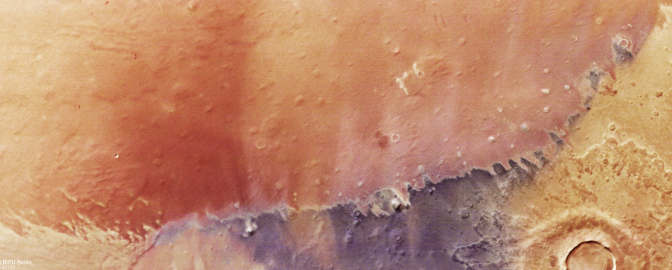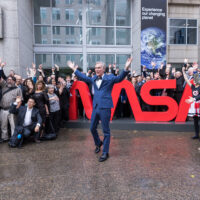The International Space Station (ISS), humanity’s shared orbital laboratory
Highlights
- The International Space Station (ISS) is a permanently crewed, multinational space laboratory in low-Earth orbit.
- Astronauts aboard the ISS help conduct a variety of science experiments, like searching for dark matter and exploring the effects of space radiation and microgravity.
- By helping space agencies discover and overcome the challenges associated with human space exploration, the ISS advances efforts toward future crewed missions like those to the Moon and Mars.
What is the International Space Station?
The International Space Station (ISS) is a permanently crewed space lab in orbit around Earth. Continuously staffed since Nov. 2, 2000, it is the longest-running space station program of all time. A variety of international partners collaborate to conduct research aboard the ISS, including five different space agencies: the National Aeronautics and Space Administration (NASA), the Japanese Aerospace Exploration Agency (JAXA), the European Space Agency (ESA), the Canadian Space Agency (CSA), and The Roscosmos State Corporation for Space Activities (Roscosmos).
The ISS is made up of many different pieces that, together, sprawl over a space about as big as a cathedral. The main body of the station consists of pressurized modules hosting laboratories, living quarters, life support systems, bathrooms, airlocks, and storage, among other things. These habitable modules occupy a volume roughly equivalent to three subway cars, with about half of that available to the crew.

Outside the pressurized modules, the rest of the ISS is exposed to the vacuum of open space. Solar arrays provide energy to the station, radiators help control its temperature, and metal pallets store equipment and spare parts. There are also robotic arms and a variety of scientific instruments.
How was the ISS built?
The construction of the ISS began with the launch of the Zarya module in 1998. Over a period spanning more than a decade, other components like laboratory modules and cargo modules were attached piece by piece to the growing station. Some were launched and then connected without human guidance. Others were delivered by Space Shuttle, then connected manually through spacewalks and the manipulation of a robotic arm contributed by Canada, called Canadarm2.
What does the ISS do?
The ISS is a versatile science lab, a testing ground for space technology, a platform for STEM education, and a symbol of international cooperation.
Astronauts on the ISS help conduct a variety of experiments. A lot of work on the station goes into studying how various aspects of the space environment, like space radiation and microgravity, affect biology and nonliving materials. The station also provides an orbital platform for experiments that monitor Earth, study space weather, and test fundamental physics. One instrument, the Alpha Magnetic Spectrometer, even searches for evidence of dark matter and antimatter.
Governments and private corporations use the ISS to figure out what challenges might confront future space exploration efforts, especially projects that put humans in space. Long-duration missions, such as flights to the Moon as part of the Artemis program, will be more complicated, harder to operate, and less forgiving than activities on the ISS. The space station offers a place to test systems and develop skills in a safer environment where help from Earth is more readily available. At the same time, extended spaceflight comes with medical risks — like vision degradation, bone loss, and muscle atrophy — that the ISS helps investigate.

The International Space Station is also a powerful tool for engaging and educating the public about space and science. Millions of students have assisted with experiments involving the ISS. Students have designed genetics experiments that flew on the ISS, written code to control a robot on the station, selected targets to be photographed from orbit, and developed ham radios to talk to the crew. Astronauts on the ISS inspire new generations of scientists, engineers, space enthusiasts, and explorers.
Lastly, the ISS is a testament to international collaboration in the name of science. The space station operates thanks to the cooperation of 15 different nations.
How to spot the ISS
Want to see the space station for yourself? Sighting the ISS is not too difficult, as it's the brightest artificial object in the night sky. Use NASA's Spot the Station tool to find out when it will fly over your location.
Who flies on the International Space Station?
Representatives of over 20 countries have visited the ISS to date, including citizens of the United States, Russia, Japan, Canada, Italy, France, Germany, UAE, Saudi Arabia, Sweden, Belgium, Brazil, Denmark, Great Britain, Kazakhstan, Malaysia, Netherlands, South Africa, South Korea, Spain, Israel, Turkey, and Belarus.

Astronauts typically staff the station in pairs of three or four-person crews assigned to overlapping six-month missions, with each unique crew complement composing a numbered Expedition (each crew member serves on two Expeditions during their stay).
The ISS also hosts private and commercial astronauts not affiliated with NASA or other space agencies. These astronauts usually stay for much shorter periods.
How is the ISS maintained?
A fleet of international and commercial spacecraft service the ISS. Current crew vehicles are Roscosmos’ Soyuz and SpaceX’s Dragon. Current cargo spacecraft are Roscosmos’ Progress (derived from the Russian Soyuz spacecraft) Dragon, as well as Cygnus, which was developed by Orbital Sciences Corporation but manufactured and launched by Northrop Grumman. In the future, Boeing's Starliner will also bring crews, while Japan's HTV-X and the Sierra Nevada Dream Chaser will bring cargo.
Day-to-day operations on the ISS are controlled and monitored by NASA’s mission control in Houston, Texas.

Why does NASA pay SpaceX and Boeing to fly astronauts to the ISS?
SpaceX's Dragon and Boeing's Starliner spacecraft were created with support from NASA's commercial crew program, a partnership between NASA and private industry to help lower the cost of spaceflight and create a new commercial market for humans in space. This initiative has NASA buy flights from private corporations to carry astronauts and other payloads to and from the International Space Station. The agency does not own or operate the spacecraft.

Acknowledgments: This page was originally written by Jason Davis. It was revised by Asa Stahl in May 2024.
Academic resources
- Trappe, S., Costill, D., Gallagher, P., Creer, A., Peters, J. R., Evans, H., Riley, D. A., & Fitts, R. H. (2009). Exercise in space: Human skeletal muscle after 6 months aboard the International Space Station. Journal of Applied Physiology, 106(4), 1159–1168.
- Cucinotta, F. A. (2014). Space radiation risks for astronauts on multiple International Space Station Missions. PLoS ONE, 9(4).
Support missions like the International Space Station
Whether it's advocating, teaching, inspiring, or learning, you can do something for space, right now. Let's get to work.


 Explore Worlds
Explore Worlds Find Life
Find Life Defend Earth
Defend Earth


